29 November 2010
What can geysers tell us about volcanoes on Earth and on distant moons?
Posted by Michael McFadden
This post is the first of a series of profiles on planetary scientists by Mark Hilverda, geoscientist and web manager for AGU’s Planetary Sciences Section. A more complete version of this interview that includes a list of reading resources was published on the new Planetary Sciences website.
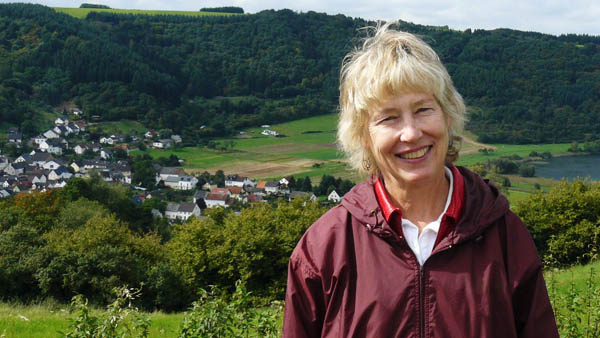
Susan Kieffer near the southern rim of the Meerfeld Maar, the largest maar in the West Eifel, Germany. Maars typically form when rising magma explosively interacts with groundwater forming a large, shallow crater. The magma that caused the formation of the Meerfeld Maar was an olivine nephelinite magma. Meerfeld, the village in the left of the photo, is located at the southwestern entrance of the Meerbach valley. Image credit: Gerard Lopez
Susan Kieffer is the Center for Advanced Study Professor of Geology and Physics at the University of Illinois at Urbana-Champaign where she holds the Charles R. Walgreen, Jr., Chair. Her research focuses on geological fluid dynamics with an emphasis on geysers, rivers, meteorite impacts, and volcanoes. An interview provided a good opportunity to catch up with her on planetary science, her career, and current research.
How did you get started in planetary science?
I’m a product of the incredible surge in U.S. science interest in the 1950’s when Sputnik was launched. By the time that John F. Kennedy said that we’d send a man to the moon, I’d already been dreaming of being there for 5 years. I didn’t take it seriously that he really did mean a “man,” and by the time women were seriously considered and Sally Ride flew in 1983, I was several decades into my career. I’ve had the luxury of studying the planets from a great foundation of geology on Earth. For me, the Earth as a planet has always been important with my work on volcanoes, rivers and terrestrial impact craters.
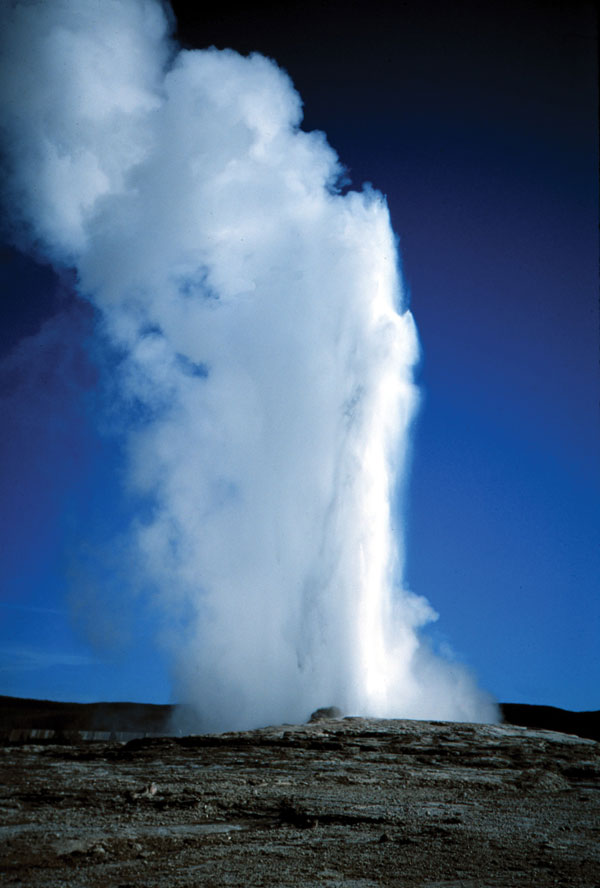
The plume of Old Faithful geyser in Yellowstone National Park erupting to a height of about 30 meters. Image credit: S. Kieffer.
In 2009, you gave the Shoemaker Lecture at the AGU Fall Meeting and discussed Saturn’s icy moon Enceladus. How did you get involved in the science of this fascinating world?
I consider Old Faithful geyser in Yellowstone to be my “field home”– my fluid dynamics interests are rooted in trying to understand that geyser and then to bring the fundamentals that I learn there to more complicated settings on the earth and other planets. Originally, I just wanted to study geysers as simple analogs to terrestrial volcanoes so that I could learn the thermodynamics well. However, shortly after I started the geyser studies, Gene Shoemaker, whom I consider the “beloved troublemaker” in my life because he was always tempting me into new research areas, came to me with the question: “Sue….we’ve just discovered eruptions on Io, could you apply your Old Faithful theory to these eruptions?” This was in 1979 and I hadn’t even started studying terrestrial volcanoes yet! He was challenging me to apply my geyser theory to sulfur and sulfur dioxide instead of water, and to the problem of eruptions into a vacuum, which brought in a completely new set of fluid dynamic constraints compared to eruptions on Earth.
When volcanoes erupt into a vacuum instead of our terrestrial atmosphere, they behave like supersonic rocket nozzles with complicated nonlinear internal waves. If Old Faithful geyser in Yellowstone erupted on the surface of Io, it would not just be a 50 meter high plume, but would tower tens of kilometers above the surface.
This work with eruptions into a vacuum put me into a very different frame of mind than most volcanologists when Mount St. Helens erupted in 1980 — I’d been thinking hard about eruptions from high-pressure magma chambers into low pressure atmospheres, and supersonic flows, so I came up with ideas outside the realm of most volcanology at the time. In particular, I believed that you could explain the pattern of tree blowdown in the most heavily devastated area near the mountain as the product of supersonic flow rather than gravity flow.
Neptune’s moon Triton with eruptions into a thin atmosphere from reservoirs at only a few tens of degrees Kelvin, and Saturn’s moon Enceladus were the next “geysers” in the sequence. Each geyser and volcano had its own unique constraints–atmospheric conditions, reservoir chemistry, and planetary geology–and after each planetary excursion, I came back to Old Faithful and terrestrial volcanism with new perspectives.
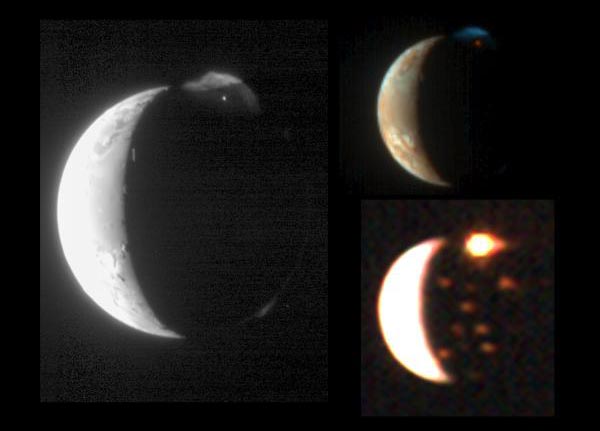
Partially lit by bright sunlight plume from Tvashtar on Io emerging from a hot lava region at its base (the small white dot under the plume in the left image). Image PIA09358 from LORRI (left), MVIC (top right) and LEISA (bottom right) on NASA's New Horizon spacecraft.
Let’s fast-forward: What topics are you currently focusing on in your research?
I’ve got a major push on in my lab to synthesize 35 years of unpublished data on Old Faithful geyser. My colleague, Jim Westphal, and I put a video camera and several temperature-pressure probes into Old Faithful and, unfortunately, we didn’t get any of our results published before his untimely death. This is unique data on the pressure and temperature conditions in the geyser, and I think that it tells us a lot about not only the thermodynamics of geysers, but also of volcanic systems (including those on Io, Triton and Enceladus) prior to eruptions.
We’ve got a number of other irons in the fire as well. With my Illinois colleagues, we’ve got an experimental program to investigate how high-speed flows from volcanoes and meteorite impacts interact with ground topography, eroding it and incorporating material into the flowing ejecta. With colleagues from Hawaii we’re trying to understand Martian impact cratering processes into an icy regolith. With colleagues at U.T. Austin, we’re still trying to conquer the challenges of modeling volcanism into the vacuum of Io. I’m also resurrecting some work on the evolution of rapids and geomorphology in the Grand Canyon and looking forward to a rafting trip through the canyon in May to check out changes there since I last went three years ago.
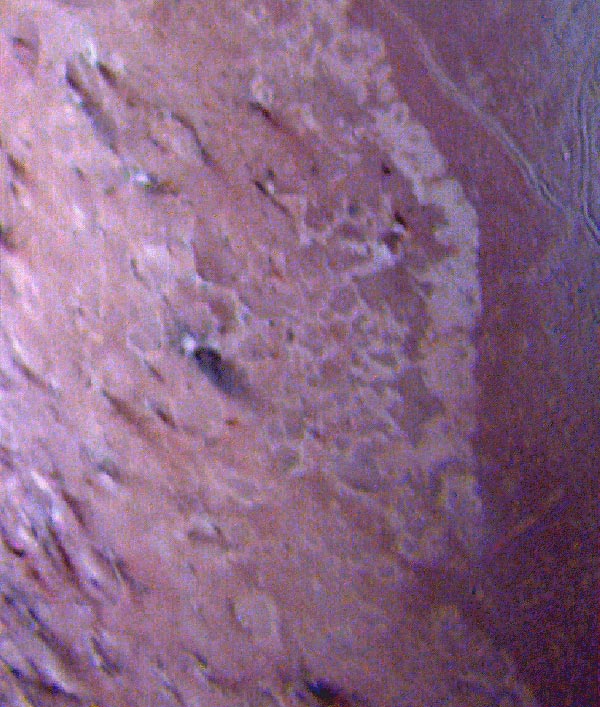
Streaks left by plumes that have erupted on Triton. The streaks may be particulate materials erupted from small circular vents (white spots at the base of the streaks) and blown in the same direction by prevailing winds. Image PIA02214 from the ISS instrument on NASA's Voyager 2 spacecraft.
Recently you’ve become quite active blogging, posting regularly to your Geology in Motion blog. What attracted you to this medium and what are some of the benefits and challenges you’ve experienced?
The blog site is a place that I’ve found that I can spend a few minutes (or an hour) a day and put together something that is both visually and intellectually pleasing. It’s a challenge to create something short and aesthetically pleasing! It’s also a convenient way to keep track of issues of interest without cluttering my desk. I’ve got a book writing project that relates to many of the issues on the blog and so it’s a handy way to store ideas and sources of material. A few friends read the blog occasionally, but since no one has really discovered it yet, there are a lot of benefits and no challenges! Maybe that will change as a result of this interview!
Could you provide any advice or tips for those who may be contemplating or beginning a career in planetary science?
I challenge my students to try to understand some process on earth really really well, right down to the basic assumptions and simplifications that are needed to model it. Take that problem, go out into the field, and into the lab and do the work that it takes to get data and test your theories. Then, and only then, transport that process to another world. If you really understand the fundamentals, your extrapolation to another planet will be well grounded. I also encourage students to develop perspectives and backgrounds in dramatically different areas than geology. For example, I never knew that my budding interest in aeronautics, developed as a grad student studying meteorite impacts, would come back multiple times in my geologic career as I studied volcanoes and rivers! And, yes, there is a link between aeronautics and rivers–I’ll let other students figure that one out, but all of my students know the answer.
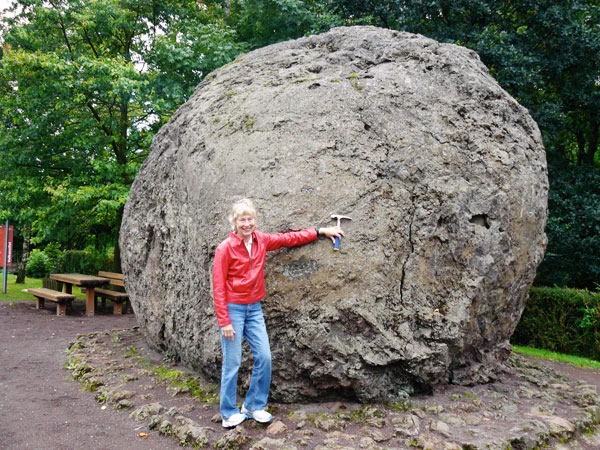
Susan Kieffer next to a large (5-meter diameter) lava bomb. Originally found on the northern rim of a basaltic scoria cone in the Wartgesberg scoria cones in Germany, this lava bomb is now "posed" near the village of Strohn. Image credit: Gerard Lopez.
Lastly, a fun “what if” scenario. If you could get more details or data on any planetary body in our solar system, which would you choose?
The obvious answer is that I’d like more data on the chemistry of the plumes of Enceladus, and high-resolution temperature data around the vents. We’ve been advocating that Enceladus is frigid and that the plumes are driven by degassing of clathrates, a process similar to that now being documented in the fantastic new images from the Deep Impact spacecraft of Comet Hartley 2 where jets of CO2 are ripping ice particles up and ejecting them into space. Clathrates are ice with molecules of other gases sitting in cages formed by water molecules. The most common clathrate on Earth is methane (CH4) clathrate. Most of the gases that have been reported in the plumes of Enceladus, such as CO2, CH4, N2, and organic molecules form clathrates and, amazingly, are more soluble in ice than in liquid water. That is a key for trying to relate the composition of the plumes to conditions in the subsurface. We expect fairly low vent temperatures and advocate that this could distinguish between cold degassing clathrate models and warm boiling water models.
Last, but perhaps most important of all, we can’t ignore the Earth. Planetary scientists have the tools and ideas to contribute a lot in the future toward monitoring and understanding what it’s going to take to keep the Earth decently habitable for future generations.
— Mark Hilverda, geoscientist and web manager for AGU’s Planetary Sciences Section










 GeoSpace is a blog on Earth and space science, managed by AGU’s Public Information staff. The blog features posts by AGU writers and guest contributors on all sorts of relevant science topics, but with a focus on new research and geo and space sciences-related stories that are currently in the news.
GeoSpace is a blog on Earth and space science, managed by AGU’s Public Information staff. The blog features posts by AGU writers and guest contributors on all sorts of relevant science topics, but with a focus on new research and geo and space sciences-related stories that are currently in the news.
These subjects as told by Prof. Kieffer are fascinating. I wish I could be a graduate student of Prof. Kieffer. I enjoyed reading the interview. My curiosity was heightened due to my graduate studies in fluid mechanics and hydraulics. I would like to thank Prof. Kieffer for advancing the knowledge of planetary science. Ogbazghi Sium, Saint Paul Minnesota
Thank you for the kind words!
I have been more than intriqued by Enceladus for some time. Your thought that it might not be hot geysers at all but a degassing process, (which I have learned about during my fairly recent fascination with volcanos), is a totally new concept that turns the “water moon with an ice crust” right on its head. However, I do have a question. Since this has been going on for a long long time it must be changing the density of the moon. How long will it take, (or will it happen at all), that the moon will collapse into itself when the density reaches an unsubstainable level to hold the crust out?
Thank you for your interest! You hit on a question that many asked very early in our thinking about the degassing: “What if this process has been going on for 4.5 billion years?” (In the following, the notation 3*10^19 means 3 times 10 to the 19th power.) If you took a rate of degassing on the high end of current estimates (200 kilograms/second), and assume that the degassing at that rate has been going on for 4.5 billion years, approximately 3*10^19 kg would have degassed. Since Enceladus now only weighs 10*10^19 kilograms, it would have lost approximately one fourth (3/10+3) of its mass over 4.5 billion years. It’s hard to reconcile that conclusion with the geology that is observed today. So, you might ask another question: “How long would it take to create the four Tiger Stripe rift valleys at the south pole with this rate of degassing?” The rift valleys have a combined volume of about 5.2*10^14 kg. This amount of ice could have been blown off in about 80,000 years at the current eruption rate, let’s say order of magnitude 100,000 years. In the five years since the original observations by Cassini, it has been learned that the geology is much more complex than either of these two examples, and that the rate of degassing has probably varied greatly over time. But, the bottom line is that even a frigid ice ball like Enceladus can have energetic and complicated geologic activity!